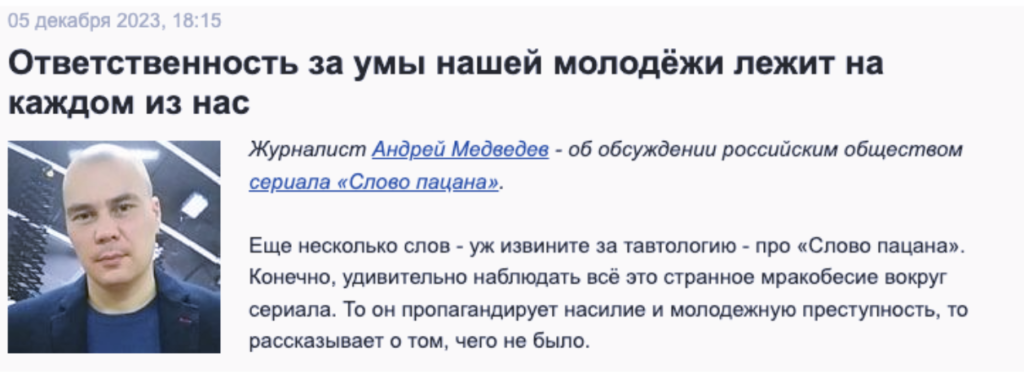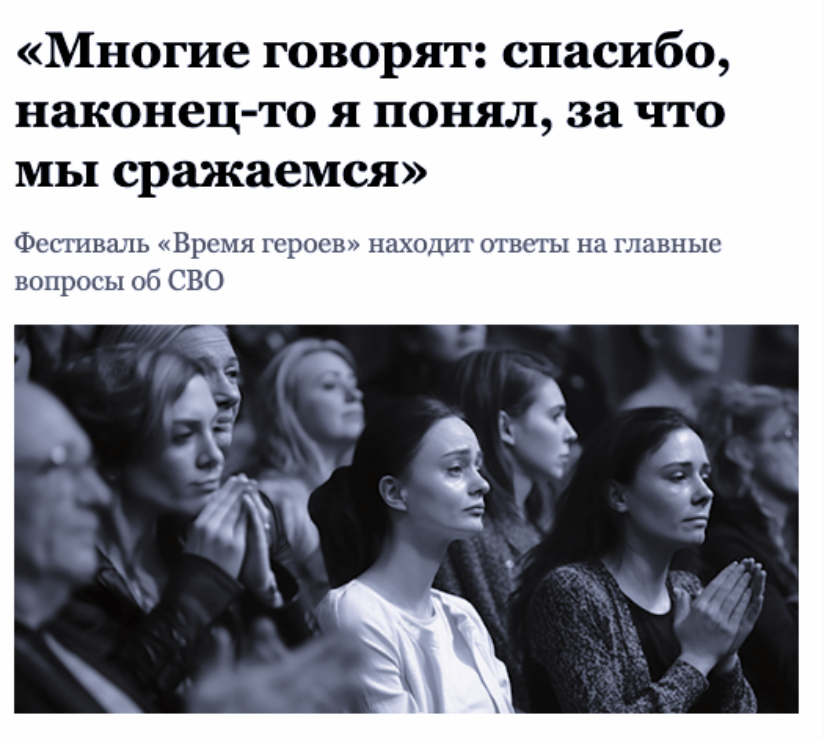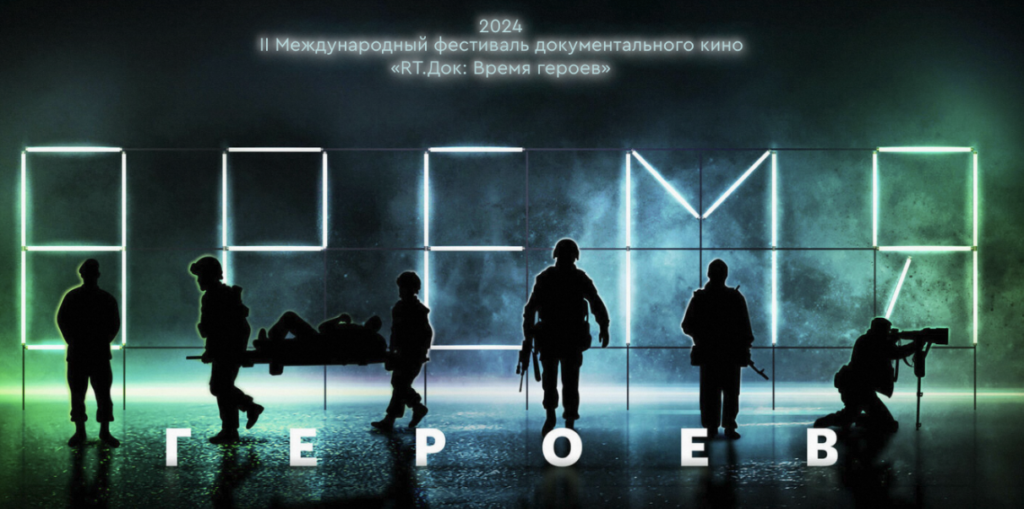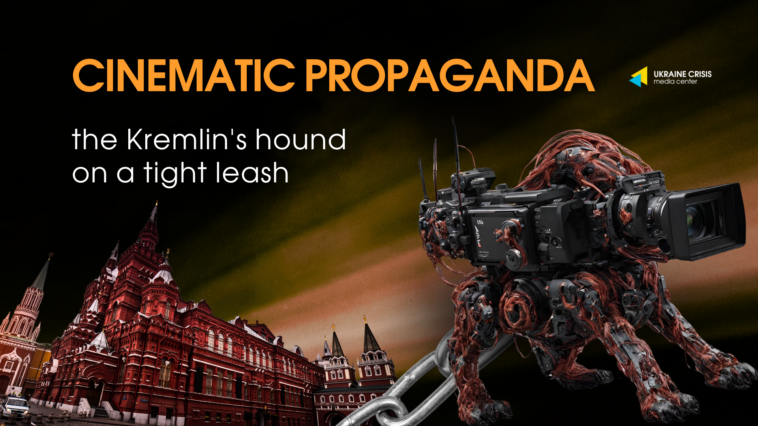“These are all such vulgar and superficial thoughts — that wars start because of resources, because of women. The war starts because there are ideas”
– a quote from the “documentary” film “Donbas Recognised”
Written by Anastasiia Ratieieva, analyst HWAG/UCMC
The tenet that “culture transcends politics” is frequently invoked when justifying the purchase and consumption of Russian cultural products. However, it is mass culture that often becomes a platform for creating new meanings that are favourable to the Kremlin and are used to manipulate public opinion. One of the most tainted cultural sectors by propaganda, continuing the Soviet tradition, is cinema.
In this article, we examine how cinema, in the Kremlin’s hands, has become an instrument of aggression against Ukraine, both in terms of worldview and humanitarian dimensions. So, what role does cinema play in the Russian propaganda machine?
Justification of the Regime’s Actions
The Ministry of Culture, the Cinema Fund, and the Internet Development Institute are the primary sources of funding for Russian cinema. In total, these bodies have allocated $1 billion for content creation between 2023 and 2025. In June 2022, a narrowly focused Fund for the Support of Military and Patriotic Cinema was established, led by the Russian Federation’s Minister of Defense. The Russian Federation’s state support for cinema is based on criteria that transform the normal procedure for financing culture into a propaganda-creation process. The Ministry of Culture’s priority themes for 2023 include “Russia’s peacekeeping mission”, “degradation of Europe”, “Malorossia as a historical region of the Russian Federation”, and “neocolonial policy of the Anglo-Saxon world”.
The film “The Witness”, released in the summer of 2023, is an example of absurd propaganda disguised as a feature film. The film, made with funds from the Russian Ministry of Culture, depicts the origins of the “SVO”. “The Witness” portrays Ukrainians as Nazis, subhumans, looters, and rapists. The Ukrainian Armed Forces care for their people solely for the benefit of Western journalists, according to the film. In one episode, the military imprisons refugees in a train station before firing on them and blaming the Russians. “Ukraine is to blame for everything,” the protagonist says in the final scene. The Russian Ministry of Culture and Ministry of Defense supported the film’s production, which cost more than $2 million.
“The Witness” is just one example of Russia’s long-standing practice of justifying its actions through the language of cinema.
Russia released the film “Olympus Inferno” in 2008, just six months after its aggression against Georgia. The film, shot in record time, portrays the Georgian military as the brutal initiators of the war, while the Russians are portrayed as “peacekeepers”. It’s interesting that only 10 days passed between the film’s release on DVD and television. Thus, the Russian people had no time to reflect, as the Kremlin quickly provided them with the “correct” version of events, packaged in an understandable and accessible format.
The Kremlin’s target audience is not limited to domestic consumers. The American Film Academy, which oversees the Oscars, recently announced that the animated film “Oneluv”, created by a Russian animator, had been selected. The cartoon’s form and plot are highly abstract, but Russian media and propagandists unanimously draw parallels to the “SVO,” which is cultivated as a necessary measure against “aggressive guests in their own home.”
This ambiguity is also aimed at Western audiences, as the film has been nominated for an Oscar. If Kremlin propaganda gives a positive meaning to any film, it raises the question of whether it is appropriate to provide platforms for the distribution of Russian cultural products.
Blurring the Borders Between Post-Soviet States – We Are One People!
In December 2023, the Russian TV series “The Word of the Boy” sparked interest among Ukrainian viewers. It was created with the help of the aforementioned Internet Development Institute, which allocates budget funds for “patriotic content”. The Institute’s list of funded projects includes a number of openly propagandistic Z-themed films. Therefore, “The Word of the Boy” is undeniably biased and politicised. However, special attention must be paid to the series’ information support, which was provided by Russian propagandists. They used the series’ popularity among Ukrainians to add colour to the narrative of “one people,” which, in the imagination of Russian imperialism, represents the population of all post-Soviet states.
“The series has increased in popularity in Ukraine to the point where people understand it is also about them. There was one country. It was falling apart just as painfully. The Russian series for street hooligans suddenly became our soft power,” writes Andrei Medvedev, a Russian journalist and film author, reminding his readers what a “loss” the Soviet Union was for everyone.
In this context, it is appropriate to recall the words of Ukrainian scholar Olena Stiazhkina about how the Russian Federation has consistently “fed” Ukrainians with its own cultural influences: “since the late 1990s, Russian television, which also ruled the Ukrainian media space, began to feed people with nostalgia for something that never really happened.” In the case of “The Word of the Boy”, the exaggerated, artificial nostalgia for the Soviet (and thus Russian and Ukrainian) past played on Ukrainian consumers’ preconceived notions.
One example demonstrates how the television series “The Word of the Boy” benefits the Kremlin. In early December, a 15-year-old boy was killed in Irkutsk, Russia. The Russian media, which covered the event, reported that the participants in the conflict were inspired by the series about youth criminal gangs, and even quoted characters from the series, according to witnesses. Instead of investigating whether “The Word of the Boy” had a negative impact on young people, authorities and propaganda began to justify the series. Top Russian propagandists agreed that the information was from Ukrainian informational psychological operation.
“It’s funny to say, but the Kazan boys of the past have suddenly become a threat to all ideological Ukrainian narratives about a special path, a special people, and eternal enmity. Is that why they want to ban it in Ukraine?” – Medvedev writes, confirming his imperialist stance.

Cultural Integration of the Occupied Territories
Following the pseudo-referendums held in Ukraine’s temporarily occupied territories in September 2022, the Russian Federation immediately announced the accession of the Zaporizhzhia and Kherson regions to its territory. The aggressor state is attempting to integrate the Ukrainian population into its own society, imposing a new, Russian identity on them. After all, if people are led to believe that “Russia is here now and forever,” de-occupation will become more difficult for Ukraine. For this purpose, the Kremlin employs all available tools, including cinema.
The documentary “Thank You, Motherland!” by the propaganda flagship RT dissolves people’s identities in the occupied territories through their “gratitude to the common homeland”. As part of the project, the film’s protagonists “returned to the regions for a few days – to their small homeland”. Among them is Crimean grandmaster Sergei Karyakin, who travels to Mariupol “to meet with the townspeople and play chess with them” after visiting the peninsula. Since Soviet times, the Kremlin has facilitated the outflow of sportspersons, including chess players, to Moscow, and this deserves separate coverage as a colonial practice. Today, the Russian Federation uses the talents stolen from Ukraine to annex the occupied regions to its cultural territory. Interestingly, Karyakin was also taken to Mariupol, which he has no connection to but is the Russian Federation’s central ideological pillar in the Russian-Ukrainian war.
The Kremlin is particularly concerned with the cultural space of the Donetsk and Luhansk regions. For example, the narrator of the “documentary” film “Donbass Recognised” (in Russian – “Donbass Recognised”) speaks about the “fundamental importance” of these territories. The justification for this importance is particularly noteworthy: “because in Donbas, these people are now… the descendants of those who built the empire and stopped at its borders. Because they are marginal, not settled, middle Russians, they recognized the threat. They… lived on the world’s border, surrounded by a hostile environment. And this world’s hostility… is not situational; it is an essential hostility to us, everyone, the Russian world in general, and the Russian idea.” Interestingly, the film’s portrayal of Donbas residents as “fringe Russians” contradicts the current Russian narrative of Ukraine’s “non-existence” and Ukrainians as separate from Russia.
The Kremlin uses the narrative of shared cultural and historical ties to justify its intervention in the Donetsk and Luhansk regions. By presenting Donbas residents as an integral part of the Russian world, the Kremlin seeks to legitimize its involvement as protecting the interests of ethnic Russians and fostering unity within what it perceives as a common cultural space.
Constructing an Alternative Reality and Glorifying War Criminals
“Documentary” propaganda films should be singled out separately. Propaganda uses “documentaries” to put its narratives on par with the facts. The concept of “documentary film” was defined as “a creative approach to reality” by John Grierson, its creator. As a result, these films claim and are perceived to be objective because they naturally reflect reality. And that is why the Kremlin uses them to manipulate public opinion through accent placement, meaning distortion, and outright lies.

Thus, in the “documentary” film “Voenkors” (short for “war correspondent”), produced by Russia’s propaganda flagship Russia Today, people directly involved in the Kremlin’s war crimes through the spread of fakes, disinformation and justification of the Kremlin’s actions become “heroes”. Just as in numerous documentaries (Always on Guard, In Our Own Eyes, Red November), Russian military personnel who committed war crimes are portrayed as “heroes”.
See also: https://uacrisis.org/en/voenkors-criminal-group-giving-meaning-to-crimes
Russian Foreign Ministry spokesperson Maria Zakharova confirms that Russian cinema is aimed at creating an alternative reality: “under the current conditions, the demand for a new language, new content, a new form of cinematic expression has increased, and the very course of events of our time encourages us to tell the audience about the real heroes with true artistic means.”
And this “storytelling” takes place quickly. For example, at the end of December, RT released the film “Marinka. Chronicle of Liberation” in three parts. Throughout 2023, the city’s destruction during hostilities was documented on film so that, once captured, the propaganda machine could quickly provide its version of events to the international community and domestic consumers.
Birch Branch: Film Festivals as a Tool
The Kremlin actively uses film festivals to create the illusion of international coverage for its film propaganda. They are an effective channel of dissemination because they are free to attend and take place across Russia. Furthermore, festivals serve as a springboard for further distribution. For example, films from the Heroes of the Great Country festival were shown to students at several educational institutions, including the Suvorov School.
“Heroes of the Great Country is supported by the Russian Ministry of Defence and the Presidential Foundation for Cultural Initiatives, which awards the best projects. The winners of 2023 include the aforementioned Donbas Recognized. Another festival, The Frontline, which in the same year awarded the RT’s Voenkorov Grand Prix, bills itself as international. The shortlist is mostly Russian, but it also includes films from Costa Rica, Kazakhstan, and Serbia. However, the films are only nominally “international” because they were created with the support of Russian institutions and citizens, and their subject matter is limited to commemorating the “great victory in the Great Patriotic War”.

The Time of Heroes festival, which will take place in Russia at the end of February 2024, will astound with the number and diversity of films. Conspiracy theories, alternative truths, and complete absurdity are presented to the audience under the guise of ‘documentary’. The festival’s shortlist includes the film Armed Barons of Ukraine, in which the authors “investigate the smuggling of weapons supplied by the West to Ukraine to hotspots around the world”. And the film “Ukraine. Children for Sale” promises viewers “evidence of black schemes to sell Ukrainian babies to wealthy paedophiles in the UK”. In general, the festival’s films explore all aspects of the Kremlin’s alternative reality. This includes the narrative “Kyiv wants to destroy the Orthodox faith”, children’s eyewitnesses “8 years of shelling in Donbas”, and much more.
In addition to the actual distribution of cultural products, festivals in the Russian Federation provide additional value: meetings with film characters and supporters of the “SVO”. “On the second anniversary of the full-scale invasion, Time of Heroes will host an open meeting with artists, musicians, and poets who have traveled to the front lines. “What drives them to the very heart of the battles? They understand that their creativity allows the soldiers to survive and defeat the enemy. “How art inspires feats and helps people believe in themselves,” the organizers explain. How can anyone believe that “culture is beyond politics” after that?
In today’s reality, Russian culture poses a hybrid threat to both the Western world and the countries where the Kremlin seeks to exert influence. Russian propaganda in the form of cinema possesses several key characteristics that make it dangerous.
– It serves to justify the regime’s actions, blur the borders between post-Soviet states, culturally integrate the occupied territories, glorify war criminals, and create an alternative reality.
– It is actively disseminated through various channels: festivals, organised screenings, and promotion through mainstream media.
– It covers almost all areas of cinema: festival films, feature films, documentaries, and TV series.
Discussions about limiting Russian cultural influences are required both in Ukraine, as part of the wartime response to hybrid threats, and around the world. Further in-depth research on this subject could provide a foundation for justifying the need for sanctions against Russia, including in the cultural sphere.



